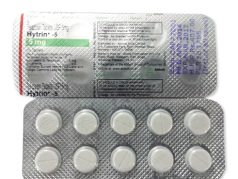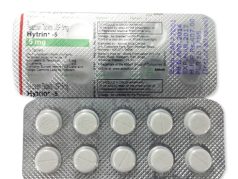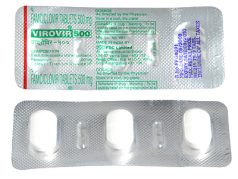Dramamine

Dramamine
- Dramamine can be purchased in pharmacies across Australia without a prescription, with options for delivery available.
- Dramamine is used for the prevention and treatment of motion sickness and nausea and vomiting. Its mechanism of action involves blocking the effects of histamine in the body, which helps reduce symptoms of motion sickness.
- The usual dosage for adults and adolescents is 50–100 mg every 4–6 hours, while for children, it is 1.25 mg/kg/dose every 6 hours (not to exceed the adult dose).
- The form of administration is typically a tablet taken orally.
- The onset time for Dramamine is approximately 30–60 minutes.
- The duration of action lasts for about 4–6 hours.
- It is advised to avoid alcohol consumption while taking Dramamine.
- The most common side effect is drowsiness.
- Would you like to try Dramamine without a prescription?
Basic Dramamine Information
| INN (International Nonproprietary Name) | Dimenhydrinate |
|---|---|
| Brand Names Available in Australia | Travacalm |
| ATC Code | A04AA05 |
| Forms & Dosages | Tablets, Chewable Tablets, Oral Solutions |
| Manufacturers in Australia | Multiple, including local distributors |
| Registration Status in Australia | Registered as an Over-The-Counter (OTC) medication |
| OTC / Rx Classification | Generally Over-The-Counter (OTC) |
Latest Research Highlights on Dimenhydrinate
Recent studies from 2022 to 2025 have shed valuable light on the efficacy and safety profile of dimenhydrinate, commonly known as Dramamine. These findings are relevant both in Australian contexts and in broader global settings.
Clinical trials have demonstrated that dimenhydrinate is effective in managing motion sickness symptoms across diverse demographic groups, contributing to its robustness in treatment protocols. Notable research from both local and international clinical trials indicates that participants across various age groups and backgrounds respond positively to the medication.
In particular, larger studies focusing on dosages for vertigo suggest that dimenhydrinate delivers reliable outcomes. Common dosages noted in trials demonstrated resolution of symptoms without severe adverse reactions. Reports indicate a significantly reduced incidence of side effects, such as drowsiness, when administered at lower doses, which is encouraging for patient adherence.
Moreover, the safety profile of this medication has been supported by data from populations with pre-existing conditions, reiterating its utility for use in the elderly and other sensitive groups. Ongoing research continues to explore its potential in various applications beyond motion sickness, tapping into areas such as anxiety management and therapeutic contexts.
As studies advance, the consensus is clear: dimenhydrinate remains a cornerstone in the treatment landscape for motion sickness, and its versatility continues to be emphasised in global medical circles, bolstering its credibility as a trusted option for those seeking relief from symptoms like nausea and vertigo.
Further Insights Into Dimenhydrinate
Looking ahead, the insights gained from ongoing research highlight potential avenues for expanded usage and support the established safety profile significantly. Keeping abreast of these developments ensures patients and healthcare professionals alike can make informed decisions regarding the use of dimenhydrinate in treatment plans.
- Reliable for managing vertigo symptoms.
- Positive outcomes across diverse demographic profiles.
- Continuous investigations into broader therapeutic applications.
Dosage Guidelines for Dramamine
Before taking any medication, understanding the proper dosage is crucial, especially with an over-the-counter product like Dramamine (dimenhydrinate). In Australia, standard recommendations dictate that adults take 50 to 100 mg every 4 to 6 hours as needed, not exceeding 400 mg in a day.
For children, the dosage is typically based on weight. A guideline is 1.25 mg per kg of body weight per dose, administered every six hours, ensuring it does not exceed adult dosages.
It's essential to remember that different formulations of dimenhydrinate exist. For instance:
- Original formula tablets come in 50 mg doses.
- Chewable tablets might offer 25 mg or 50 mg options, making it easier for younger patients.
Specific age-related adjustments are necessary:
- For the elderly, a lower starting dose could be beneficial, considering they might have increased sensitivity to anticholinergics.
- Severe renal or hepatic impairment should lead to careful dosage evaluation due to limited data on safety.
Always ensure the correct administration route—typically oral. For anyone considering regular use, such as during travel, it's wise to take it 30 to 60 minutes before the anticipated motion sickness trigger. Following PBS guidelines helps avoid exceeding safe maximums.
Interactions Overview
Understanding potential interactions is as critical as knowing the dosage when it comes to medications like Dramamine. Numerous substances can influence the effectiveness and safety of dimenhydrinate.
Alcohol is a significant contender; combining it with Dramamine may enhance sedation, leading to impaired coordination and judgement. Caffeine can potentially counteract some of the sedative effects, but caution is advised since mixing them can lead to unpredictable results.
Drug interactions also deserve attention. The Therapeutic Goods Administration (TGA) highlights areas of concern with other medications. For example:
- Prescription sedatives or anti-anxiety medications can compound drowsiness.
- Anticholinergics or other antihistamines may heighten side effects like dry mouth and blurred vision.
Pharmacists play a vital role in guiding patients about these interactions. They can help ensure that individuals taking other medications understand how Dramamine may affect their regimen. Awareness is the key to safe usage—always disclose all medications to your healthcare provider or pharmacist.
Cultural Perceptions & Patient Habits
Australian patient forums indicate varied perceptions surrounding dimenhydrinate. Many discussions emphasise a sense of trust in medications like Dramamine for motion sickness but highlight a growing awareness of potential side effects.
Access patterns also vary significantly, especially between rural and urban areas. Urban residents often have several pharmacy options at their disposal, including Chemist Warehouse, whereas rural communities may rely on fewer local chemists which might affect the availability of specific brands like Dramamine or alternatives like Travacalm.
Price sensitivity is also noteworthy. Many patients utilise PBS subsidies to manage costs effectively. For some, the absence of discounts can deter them from purchasing necessary medication, affecting adherence.
Shared experiences from various users reveal both practical benefits and occasional skepticism towards long-term usage of dimenhydrinate, particularly regarding dependency worries.
Considerations like this reflect broader cultural habits around medication usage and health at risk for miscommunication. Given the frequency of travel and potential for motion sickness among Australians, this medication remains prevalent in conversations, often leading to recommendations among peers about where to buy Dramamine.
Availability & Pricing Patterns
In Australia, dimenhydrinate, commonly under the brand name Dramamine, is readily available. Major pharmacy chains like Chemist Warehouse and Priceline stock it both in-store and online. This accessibility has made it easier for consumers to find suitable options, whether seeking the original formula or alternatives such as Travacalm.
When examining price patterns, PBS coverage often plays a decisive role in consumer decisions. As a rule, medications that fall under this scheme tend to be more affordable, granting subsidised access to necessary treatment for motion sickness.
For those seeking alternative purchasing avenues, online pharmacies provide a convenient option, although it's crucial to ensure they’re legitimate. A simple search for “buy dramamine near me” typically yields various choices.
Weekly sales or promotions at local chemists can shift prices significantly. For those comparing Travacalm vs. Dramamine, noting the price differences might stir concerns about which is more cost-effective under certain circumstances.
Due to these patterns, patient purchasing decisions are shaped not just by health needs but also by the availability of cheaper options through PBS versus out-of-pocket expenses. Overall, the balance between access, price, and awareness of available remedies continues to influence buying behaviours significantly in Australia.
Comparable Medicines and Preferences
When considering alternatives to dimenhydrinate, particularly popular brands like Dramamine, consumers often weigh the pros and cons of various competitors available in Australia.
Two significant alternatives worth noting are Meclizine and Scopolamine.
- Meclizine (found in medications like Bonine): This is often hailed for being less sedative than dimenhydrinate, making it appealing for those who want to avoid drowsiness. However, it may not work as effectively for some individuals with severe motion sickness. Consumer experiences vary widely, with some praising its gentle effect, while others miss the stronger action of Dramamine.
- Scopolamine (available as Transderm Scop): The transdermal patch offers a longer duration of action and is particularly useful for individuals prone to severe motion sickness. Its downside? Users may face side effects like dry mouth and blurred vision, which can deter its use. It’s often recommended for longer trips.
Consumer preferences also hinge significantly on side effects and effectiveness. When comparing Travacalm vs. Dramamine, some users find Travacalm more palatable and easier to take, thanks to its formulation. On the other hand, others swear by Dramamine for its powerful anti-nausea effects, making the choice subjective.
Interestingly, natural remedies are gaining traction too. Ginger, for example, is widely recognised for aiding with nausea and is often seen as a gentler alternative without the side effects associated with pharmaceuticals. Regardless of options, it's clear that the choice is personal, hinging on how each drug interacts with the individual’s body.
FAQ Section
Dimenhydrinate, commonly known as Dramamine, often raises important questions, especially among those considering its use in special circumstances like pregnancy or for children.
A common question is, “Can you take Dramamine while pregnant?” Research indicates it’s classified as safe during pregnancy when used as directed. However, consulting a healthcare professional remains vital for personalised advice.
Another frequent inquiry concerns the safety of using Dramamine for kids in Australia. The medication is available in dosages suitable for children, but parents should adhere strictly to the dosing guidelines based on the child's weight. Always consult a paediatrician before introducing any new medication to ensure safety.
Additionally, questions like “What is Dramamine used for?” and “Is Dramamine over the counter in Australia?” are common. In Australia, Dramamine serves as an over-the-counter remedy primarily for motion sickness, with easy access through various pharmacies.
Guidelines for Proper Use
Guidelines for using dimenhydrinate are essential, and Australian pharmacists play a crucial role in advising patients correctly.
The Therapeutic Goods Administration (TGA) recommends that individuals follow the dosage instructions on the packaging. Typical dosages for adults include 50–100 mg every 4–6 hours as required, but it's key to avoid exceeding the maximum daily limit of 400 mg. Pharmacists also guide patients on potential side effects, with drowsiness being the most common.
Key points to remember include:
- Store dimenhydrinate at a stable room temperature, away from excess moisture and heat.
- Discuss any existing health conditions such as asthma or epilepsy with a healthcare provider, as they may warrant caution against using this medication.
- Consult with a healthcare professional regarding its use in conjunction with other medications, especially for elderly patients or those with renal or hepatic impairment.
Ultimately, staying informed through reliable patient resources and adhering to TGA recommendations will ensure safe usage of dimenhydrinate throughout holidays or when travelling.
Delivery Information for Dramamine
| City | Region | Delivery Time |
|---|---|---|
| Sydney | New South Wales | 5–7 days |
| Melbourne | Victoria | 5–7 days |
| Brisbane | Queensland | 5–7 days |
| Perth | Western Australia | 5–7 days |
| Adelaide | South Australia | 5–7 days |
| Canberra | Australian Capital Territory | 5–7 days |
| Hobart | Tasmania | 5–9 days |
| Gold Coast | Queensland | 5–9 days |
| Newcastle | New South Wales | 5–9 days |
| Wollongong | New South Wales | 5–9 days |
| Cairns | Queensland | 5–9 days |
| Geelong | Victoria | 5–9 days |










